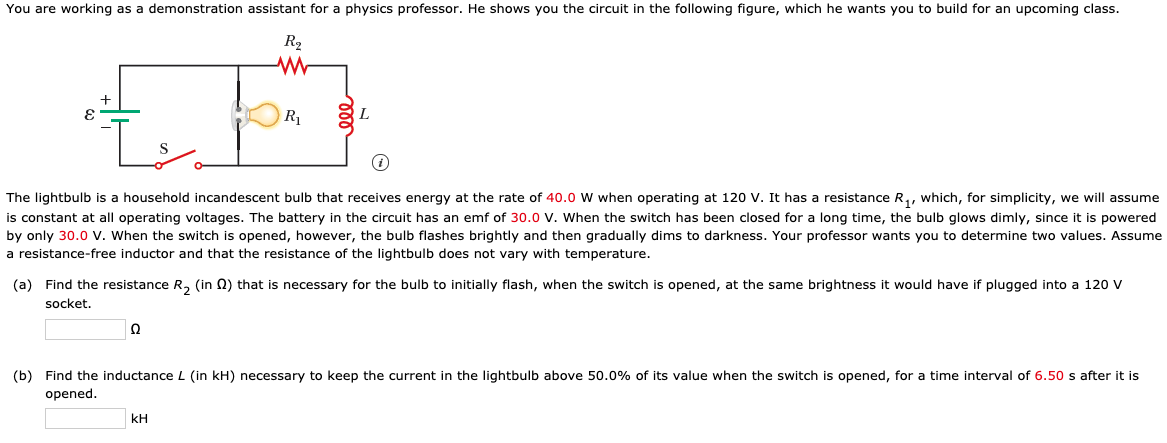You are working as a demonstration assistant for a physics professor. He shows you the circuit in the following figure, which he wants you to build for an upcoming class. R2 R1 The lightbulb is a household incandescent bulb that receives energy at the rate of 40.0 W when operating at 120 V. It has a resistance R,, which, for simplicity, we will assume is constant at all operating voltages. The battery in the circuit has an emf of 30.0 V. When the switch has been closed for a long time, the bulb glows dimly, since it is powered by only 30.0 v. When the switch is opened, however, the bulb flashes brightly and then gradually dims to darkness. Your professor wants you to determine two values. Assume a resistance-free inductor and that the resistance of the lightbulb does not vary with temperature. (a) Find the resistance R, (in Q) that is necessary for the bulb to initially flash, when the switch is opened, at the same brightness it would have if plugged into a 120 v socket. Ω (b) Find the inductance L (in kH) necessary to keep the current in the lightbulb above 50.0% of its value when the switch is opened, for a time interval of 6.50 s after it is opened. kH
You are working as a demonstration assistant for a physics professor. He shows you the circuit in the following figure, which he wants you to build for an upcoming class. R2 R1 The lightbulb is a household incandescent bulb that receives energy at the rate of 40.0 W when operating at 120 V. It has a resistance R,, which, for simplicity, we will assume is constant at all operating voltages. The battery in the circuit has an emf of 30.0 V. When the switch has been closed for a long time, the bulb glows dimly, since it is powered by only 30.0 v. When the switch is opened, however, the bulb flashes brightly and then gradually dims to darkness. Your professor wants you to determine two values. Assume a resistance-free inductor and that the resistance of the lightbulb does not vary with temperature. (a) Find the resistance R, (in Q) that is necessary for the bulb to initially flash, when the switch is opened, at the same brightness it would have if plugged into a 120 v socket. Ω (b) Find the inductance L (in kH) necessary to keep the current in the lightbulb above 50.0% of its value when the switch is opened, for a time interval of 6.50 s after it is opened. kH
Introductory Circuit Analysis (13th Edition)
13th Edition
ISBN:9780133923605
Author:Robert L. Boylestad
Publisher:Robert L. Boylestad
Chapter1: Introduction
Section: Chapter Questions
Problem 1P: Visit your local library (at school or home) and describe the extent to which it provides literature...
Related questions
Question

Transcribed Image Text:You are working as a demonstration assistant for a physics professor. He shows you the circuit in the following figure, which he wants you to build for an upcoming class.
R2
R1
The lightbulb is a household incandescent bulb that receives energy at the rate of 40.0 W when operating at 120 V. It has a resistance R,, which, for simplicity, we will assume
is constant at all operating voltages. The battery in the circuit has an emf of 30.0 V. When the switch has been closed for a long time, the bulb glows dimly, since it is powered
by only 30.0 v. When the switch is opened, however, the bulb flashes brightly and then gradually dims to darkness. Your professor wants you to determine two values. Assume
a resistance-free inductor and that the resistance of the lightbulb does not vary with temperature.
(a) Find the resistance R, (in Q) that is necessary for the bulb to initially flash, when the switch is opened, at the same brightness it would have if plugged into a 120 v
socket.
Ω
(b) Find the inductance L (in kH) necessary to keep the current in the lightbulb above 50.0% of its value when the switch is opened, for a time interval of 6.50 s after it is
opened.
kH
Expert Solution
This question has been solved!
Explore an expertly crafted, step-by-step solution for a thorough understanding of key concepts.
This is a popular solution!
Trending now
This is a popular solution!
Step by step
Solved in 2 steps with 5 images

Knowledge Booster
Learn more about
Need a deep-dive on the concept behind this application? Look no further. Learn more about this topic, electrical-engineering and related others by exploring similar questions and additional content below.Recommended textbooks for you

Introductory Circuit Analysis (13th Edition)
Electrical Engineering
ISBN:
9780133923605
Author:
Robert L. Boylestad
Publisher:
PEARSON

Delmar's Standard Textbook Of Electricity
Electrical Engineering
ISBN:
9781337900348
Author:
Stephen L. Herman
Publisher:
Cengage Learning

Programmable Logic Controllers
Electrical Engineering
ISBN:
9780073373843
Author:
Frank D. Petruzella
Publisher:
McGraw-Hill Education

Introductory Circuit Analysis (13th Edition)
Electrical Engineering
ISBN:
9780133923605
Author:
Robert L. Boylestad
Publisher:
PEARSON

Delmar's Standard Textbook Of Electricity
Electrical Engineering
ISBN:
9781337900348
Author:
Stephen L. Herman
Publisher:
Cengage Learning

Programmable Logic Controllers
Electrical Engineering
ISBN:
9780073373843
Author:
Frank D. Petruzella
Publisher:
McGraw-Hill Education

Fundamentals of Electric Circuits
Electrical Engineering
ISBN:
9780078028229
Author:
Charles K Alexander, Matthew Sadiku
Publisher:
McGraw-Hill Education

Electric Circuits. (11th Edition)
Electrical Engineering
ISBN:
9780134746968
Author:
James W. Nilsson, Susan Riedel
Publisher:
PEARSON

Engineering Electromagnetics
Electrical Engineering
ISBN:
9780078028151
Author:
Hayt, William H. (william Hart), Jr, BUCK, John A.
Publisher:
Mcgraw-hill Education,